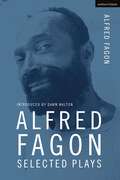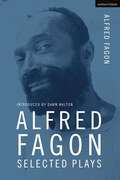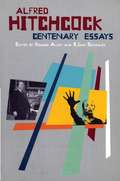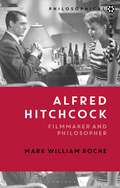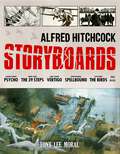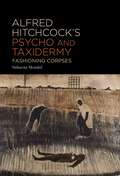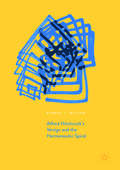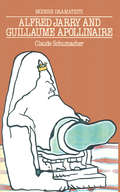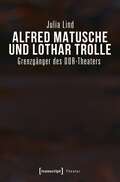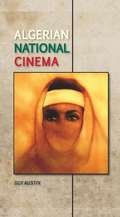- Table View
- List View
Alfred Bester’s The Stars My Destination: A Critical Companion (Palgrave Science Fiction and Fantasy: A New Canon)
by D. Harlan WilsonIn this comprehensive study of The Stars My Destination, D. Harlan Wilson makes a case for the continued significance of Alfred Bester’s SF masterwork, exploring its distinctive style, influences, intertextuality, affect, and innovation as well as its extensive metafictional properties. In Stars, Bester established himself as a son of the pulp-SF and high-modernist writers that preceded him and a forefather to the New Wave and cyberpunk movements that followed his lead. Wilson’s study depicts Bester as an SF insider as much as an outlier, writing in the spirit of the genre but breaking with the fixation on hard science in favor of psychological interiority, literary experimentation, and adult themes. The book combines close-readings of the novel with broader concerns about contemporary media, technoculture, and the current state of SF itself. In Wilson’s view, SF is a moribund artform, and Stars foresaw the inevitable science fictionalization of our benighted world. With scholarly lucidity and precision, Wilson shows us that Stars pointed the way to what we have (un)become.
Alfred Fagon Selected Plays
by Alfred FagonDespite the legacy of his eponymous award, Alfred Fagon's stage works have often been forgotten due to them not being available. This anthology of selected plays brings together his shorter works for the first time into one volume that expands his legacy and confirms his place as one of Britain's key writing talents of the twentieth century. Originally an actor, Fagon's writing for the stage, film and television grew throughout the early 1970s, before his breakaway hit The Death of A Black Man was produced at the Hampstead Theatre in 1975. Now one of British theatre's most well-known names, Fagon's legacy is secured due in no small part to the commemorative award in his honour that was established following his death in 1986, to recognise Black British playwrights from the Caribbean, resident in the United Kingdom. Brought together with a critical introduction from Dawn Walton OBE, this collection also includes a reflection and response from a former winner of the Alfred Fagon award, Juliet Gilkes Romero. The plays include: A Day in the Bristol Air Raid Shelter Adventure Inside Thirteen Four Hundred Pounds No Soldiers in St Paul's Shakespeare Country Small World Weekend Lovers
Alfred Fagon Selected Plays
by Alfred FagonDespite the legacy of his eponymous award, Alfred Fagon's stage works have often been forgotten due to them not being available. This anthology of selected plays brings together his shorter works for the first time into one volume that expands his legacy and confirms his place as one of Britain's key writing talents of the twentieth century. Originally an actor, Fagon's writing for the stage, film and television grew throughout the early 1970s, before his breakaway hit The Death of A Black Man was produced at the Hampstead Theatre in 1975. Now one of British theatre's most well-known names, Fagon's legacy is secured due in no small part to the commemorative award in his honour that was established following his death in 1986, to recognise Black British playwrights from the Caribbean, resident in the United Kingdom. Brought together with a critical introduction from Dawn Walton OBE, this collection also includes a reflection and response from a former winner of the Alfred Fagon award, Juliet Gilkes Romero. The plays include: A Day in the Bristol Air Raid Shelter Adventure Inside Thirteen Four Hundred Pounds No Soldiers in St Paul's Shakespeare Country Small World Weekend Lovers
Alfred Hitchcock: Centenary Essays
by Richard Allen S. Ishii-GonzalèsThis collection of essays displays the range and breadth of Hitchcock scholarship and assesses the significance of his body of work as a bridge between the fin de siecle culture of the 19th century and the 20th century. It engages with Hitchcock's characteristic formal and aesthetic preoccupations.
Alfred Hitchcock
by Nicholas HaeffnerNicholas Haeffner provides a comprehensive introduction to Alfred Hitchcock's major British and Hollywood films and usefully navigates the reader through a wealth of critical commentaries. One of the acknowledged giants of film, Hitchcock's prolific half-century career spanned the silent and sound eras and resulted in 53 films of which Rear Window (1954), Vertigo (1958) and Psycho (1960) are now seen as classics within the suspense, melodrama and horror genres. In contrast to previous works, which have attempted to get inside Hitchcock's mind and psychoanalyse his films, this book takes a more materialist stance. As Haeffner makes clear, Hitchcock was simultaneously a professional film maker working as part of a team in the film factories of Hollywood, a media celebrity, and an aspiring artist gifted with considerable entrepreneurial flair for marketing himself and his films. The book makes a case for locating the director's remarkable body of work within traditions of highbrow, middlebrow and lowbrow culture, appealing to different audience constituencies in a calculated strategy. The book upholds the case for taking Hitchcock's work seriously and challenges his popular reputation as a misogynist through detailed analyses of his most controversial films.
Alfred Hitchcock
by Nicholas HaeffnerNicholas Haeffner provides a comprehensive introduction to Alfred Hitchcock's major British and Hollywood films and usefully navigates the reader through a wealth of critical commentaries. One of the acknowledged giants of film, Hitchcock's prolific half-century career spanned the silent and sound eras and resulted in 53 films of which Rear Window (1954), Vertigo (1958) and Psycho (1960) are now seen as classics within the suspense, melodrama and horror genres. In contrast to previous works, which have attempted to get inside Hitchcock's mind and psychoanalyse his films, this book takes a more materialist stance. As Haeffner makes clear, Hitchcock was simultaneously a professional film maker working as part of a team in the film factories of Hollywood, a media celebrity, and an aspiring artist gifted with considerable entrepreneurial flair for marketing himself and his films. The book makes a case for locating the director's remarkable body of work within traditions of highbrow, middlebrow and lowbrow culture, appealing to different audience constituencies in a calculated strategy. The book upholds the case for taking Hitchcock's work seriously and challenges his popular reputation as a misogynist through detailed analyses of his most controversial films.
Alfred Hitchcock: Filmmaker and Philosopher (Philosophical Filmmakers)
by Mark William RocheHitchcock was a masterful director, popular with audiences of all ages and critically acclaimed both during and after his unusually long career. What may have been sensed by many viewers but not fully articulated until now is the extent to which his works subtly engage philosophical themes: What is evil, and how does it shield and reveal itself? Can we know what is inside the mind of another person? What is at stake when one knows the truth but cannot speak of it or cannot persuade others? How is Hitchcock's loving critique of humanity manifested in his films? Why are Hitchcock's works so often ambiguous? What is the hidden purpose and theory behind his use of humor?Hitchcock employs cinematic techniques–from camera angles and use of light to editing and sound–partly to convey suspense and drama but also to engage and advance philosophical issues, ranging from identity crises to moral ugliness. Roche unlocks Hitchcock's engagement with philosophical themes, and he does so in a way that appeals to both the novice and the seasoned philosopher, as well as enthusiastic admirers of Hitchcock's films.
Alfred Hitchcock: Filmmaker and Philosopher (Philosophical Filmmakers)
by Mark William RocheHitchcock was a masterful director, popular with audiences of all ages and critically acclaimed both during and after his unusually long career. What may have been sensed by many viewers but not fully articulated until now is the extent to which his works subtly engage philosophical themes: What is evil, and how does it shield and reveal itself? Can we know what is inside the mind of another person? What is at stake when one knows the truth but cannot speak of it or cannot persuade others? How is Hitchcock's loving critique of humanity manifested in his films? Why are Hitchcock's works so often ambiguous? What is the hidden purpose and theory behind his use of humor?Hitchcock employs cinematic techniques–from camera angles and use of light to editing and sound–partly to convey suspense and drama but also to engage and advance philosophical issues, ranging from identity crises to moral ugliness. Roche unlocks Hitchcock's engagement with philosophical themes, and he does so in a way that appeals to both the novice and the seasoned philosopher, as well as enthusiastic admirers of Hitchcock's films.
Alfred Hitchcock: Centenary Essays
This collection of essays displays the range and breadth of Hitchcock scholarship and assesses the significance of his body of work as a bridge between the fin de siecle culture of the 19th century and the 20th century. It engages with Hitchcock's characteristic formal and aesthetic preoccupations.
Alfred Hitchcock Storyboards
by Tony MoralTo coincide with the 100th anniversary of his directorial debut in 2022, this stunning coffee table book focuses on the storyboards, including never before published images and incisive text putting the material in context and examining the role the pieces played in some of the most unforgettable scenes in cinema. Hitchcock author and aficionado Tony Lee Moral takes you through the last 100 years of cinema, with the Master of Suspense as your guide. Join him behind the scenes as he reveals the locations, characters and motifs which make up a Hitchcock movie, with exclusive on set photography, concept art, costume designs, scene breakdowns, and more, accompanied by cast and crew interviews.
Alfred Hitchcock's America (America Through the Lens)
by Murray PomeranceWith a sharp eye for social detail and the pressures of class inequality, Alfred Hitchcock brought to the American scene a perspicacity and analytical shrewdness unparalleled in American cinema. Murray Pomerance works from a basis in cultural analysis and a detailed knowledge of Alfred Hitchcock's films and production techniques to explore how America of the 1940s, 1950s, and 1960s is revealed and critically commented upon in Hitchcock's work. Alfred Hitchcock's America is full of stunning details that bring new light to Hitchcock's method and works. The American "spirit of place," is seen here in light of the titanic American personality, American values in a consumer age, social class and American social form, and the characteristic American marriage. The book’s analysis ranges across a wide array of films from Rebecca to Family Plot, and examines in depth the location sequences, characterological types, and complex social expectations that riddled American society while Hitchcock thrived there.
Alfred Hitchcock's America (America Through the Lens)
by Murray PomeranceWith a sharp eye for social detail and the pressures of class inequality, Alfred Hitchcock brought to the American scene a perspicacity and analytical shrewdness unparalleled in American cinema. Murray Pomerance works from a basis in cultural analysis and a detailed knowledge of Alfred Hitchcock's films and production techniques to explore how America of the 1940s, 1950s, and 1960s is revealed and critically commented upon in Hitchcock's work. Alfred Hitchcock's America is full of stunning details that bring new light to Hitchcock's method and works. The American "spirit of place," is seen here in light of the titanic American personality, American values in a consumer age, social class and American social form, and the characteristic American marriage. The book’s analysis ranges across a wide array of films from Rebecca to Family Plot, and examines in depth the location sequences, characterological types, and complex social expectations that riddled American society while Hitchcock thrived there.
Alfred Hitchcock’s Psycho and Taxidermy: Fashioning Corpses
by Subarna MondalThere are numerous scholarly works on Alfred Hitchcock's Psycho (1960). Some of these works have explored its Gothic potentials. However, no detailed effort has yet been made to explore one of its major motifs – taxidermy. Taxidermy as an art of corporeal preservation has effectively been used in mainstream body horror films years after Psycho was released. Yet Psycho was one of the first films to explore its potentials in the Gothic genre at a time when it was relegated to a low form of art. Alfred Hitchcock's Psycho and Taxidermy focuses on taxidermy as a cultural practice in both Victorian and modern times and how it has been employed both metaphorically and literally in Hitchcock's films, especially Psycho. It also situates Psycho as a crucial film in the filmic continuum of body horrors where death and docility share a troubled relationship.
Alfred Hitchcock’s Psycho and Taxidermy: Fashioning Corpses
by Subarna MondalThere are numerous scholarly works on Alfred Hitchcock's Psycho (1960). Some of these works have explored its Gothic potentials. However, no detailed effort has yet been made to explore one of its major motifs – taxidermy. Taxidermy as an art of corporeal preservation has effectively been used in mainstream body horror films years after Psycho was released. Yet Psycho was one of the first films to explore its potentials in the Gothic genre at a time when it was relegated to a low form of art. Alfred Hitchcock's Psycho and Taxidermy focuses on taxidermy as a cultural practice in both Victorian and modern times and how it has been employed both metaphorically and literally in Hitchcock's films, especially Psycho. It also situates Psycho as a crucial film in the filmic continuum of body horrors where death and docility share a troubled relationship.
Alfred Hitchcock's Vertigo and the Hermeneutic Spiral
by Robert J. BeltonThis book offers a new approach to film studies by showing how our brains use our interpretations of various other films in order to understand Alfred Hitchcock’s Vertigo. Borrowing from behavioral psychology, cognitive science and philosophy, author Robert J. Belton seeks to explain differences of critical opinion as inevitable. The book begins by introducing the hermeneutic spiral, a cognitive processing model that categorizes responses to Vertigo’s meaning, ranging from wide consensus to wild speculations of critical “outliers.” Belton then provides an overview of the film, arguing that different interpreters literally see and attend to different things. The fourth chapter builds on this conclusion, arguing that because people see different things, one can force the production of new meanings by deliberately drawing attention to unusual comparisons. The latter chapters outline a number of such comparisons—including avant-garde films and the works of Stanley Kubrick and David Lynch—to shed new light on the meanings of Vertigo.
Alfred Hitchcock's Vertigo and the Hermeneutic Spiral
by Robert J. BeltonThis book offers a new approach to film studies by showing how our brains use our interpretations of various other films in order to understand Alfred Hitchcock’s Vertigo. Borrowing from behavioral psychology, cognitive science and philosophy, author Robert J. Belton seeks to explain differences of critical opinion as inevitable. The book begins by introducing the hermeneutic spiral, a cognitive processing model that categorizes responses to Vertigo’s meaning, ranging from wide consensus to wild speculations of critical “outliers.” Belton then provides an overview of the film, arguing that different interpreters literally see and attend to different things. The fourth chapter builds on this conclusion, arguing that because people see different things, one can force the production of new meanings by deliberately drawing attention to unusual comparisons. The latter chapters outline a number of such comparisons—including avant-garde films and the works of Stanley Kubrick and David Lynch—to shed new light on the meanings of Vertigo.
Alfred Matusche und Lothar Trolle: Grenzgänger des DDR-Theaters (Theater #111)
by Julia LindEigensinn und SED-Diktatur? Trotz des Diktats der Gleichheit vertraten die Dramatiker Alfred Matusche und Lothar Trolle in der DDR eine eigenständige künstlerische Position. Beide orientierten sich dabei an Traditionslinien der Moderne, welche im kulturellen System der DDR unterrepräsentiert waren. Während Matusche einen sozialistischen mit einem magischen Realismus verknüpfte, entwickelte Trolle Formen des Absurden weiter. Julia Lind stellt diese ungleichen Grenzgänger des DDR-Theaters anhand ausgewählter Theatertexte, Theaterinszenierungen sowie Hör- und Fernsehspiele vor und eröffnet damit einen ungewöhnlichen, »von den Rändern des Sozialismus ausgehenden« Blick auf die deutsch-deutsche Geschichte.
Alfredo Roces: Digital Paintings
Alfredo Roces: Digital Paintings features the digital art creation of a polymathic Filipino artist. Though formally trained in the traditional school of fine arts—where in the mid-fifties, the artist took up drawing classes with German Expressionist and Dadaist, George Grosz at the Art Students League of New York—Roces welcomed with gusto the offer of new technologies for his artmaking. The artist’s encounter with “Photoshop” in 2004 would eventually set the stage for his ongoing adventures with digital artmaking—when in 2011, nearing eighty years of age, he discovered the Big Apple and found his Eden with “Brushes” (and later on, “Procreate”) in iPad. The book presents a selection of more than a hundred of Roces’s iPad drawings in various genres—portrait, still life, human figure, and abstract—and shows to full effect the artist’s zest for life. The book is prologued with an interview with the editor, David Jonathan Bayot, in which Roces tells of a life so far and speaks of his dreams for the tomorrows ahead. A prefatory interview is complemented by the artist’s own account of his “adventures with digital art.” In the words of Tina Colayco, President of the Metropolitan Museum of Manila: "There is much to be admired with Alfredo Roces who at 90 remains an authentic and authoritative persona in Philippine art and culture. The book captures the essence of Roces as a Filipino artist, the zeitgeist of so many decades, and a continuing passion to create art. It brings to the fore the journey of the gentleman-artist described in the epigraph to the book as ‘sitting in the Row of a morning’.”
Algarve Building: Modernism, Regionalism and Architecture in the South of Portugal, 1925-1965
by Ricardo AgarezForeword by Adrian Forty. The Algarve is not only Portugal’s foremost tourism region. Uniquely Mediterranean in an Atlantic country, its building customs have long been markers of historical and cultural specificity, attracting both picturesque driven conservatives and modernists seeking their lineage. Modernism, regionalism and the ‘vernacular’ – three essential tropes of twentieth-century architecture culture – converged in the region’s building identity construct and, often the subject of strictly metropolitan elaborations, they are examined here from a peripheral standpoint instead. Drawing on work that won the Royal Institute of British Architects President’s Award for Outstanding PhD Thesis in 2013, Algarve Building challenges the conventional inclusion of Portuguese modern architecture in ‘Critical Regionalism’ narratives. A fine-grain reconstruction of the debates and cultures at play locally exposes the extra-architectural and widely participated antecedents of the much-celebrated mid-century shift towards the regional. Uncelebrated architects and a cast of other players (clients, officials, engineers and builders) contributed to maturing a regional strand of modern architecture that, more than being the heroic outcome of a hard-fought ‘battle’ by engaged designers against a conservative establishment, became truly popular in the Algarve. Algarve Building shows, more broadly, what the processes that have been appropriated by the canon of architectural history and theory – such as the presence of folk traditions and regional variation in learned architecture – stand to gain when observed in local everyday practices. The grand narratives and petites histoires of architecture can be enriched, questioned, revised and confirmed by an unprejudiced return to its facts and sources – the buildings, the documents, the discourses, the agents and the archives.
Algarve Building: Modernism, Regionalism and Architecture in the South of Portugal, 1925-1965
by Ricardo AgarezForeword by Adrian Forty. The Algarve is not only Portugal’s foremost tourism region. Uniquely Mediterranean in an Atlantic country, its building customs have long been markers of historical and cultural specificity, attracting both picturesque driven conservatives and modernists seeking their lineage. Modernism, regionalism and the ‘vernacular’ – three essential tropes of twentieth-century architecture culture – converged in the region’s building identity construct and, often the subject of strictly metropolitan elaborations, they are examined here from a peripheral standpoint instead. Drawing on work that won the Royal Institute of British Architects President’s Award for Outstanding PhD Thesis in 2013, Algarve Building challenges the conventional inclusion of Portuguese modern architecture in ‘Critical Regionalism’ narratives. A fine-grain reconstruction of the debates and cultures at play locally exposes the extra-architectural and widely participated antecedents of the much-celebrated mid-century shift towards the regional. Uncelebrated architects and a cast of other players (clients, officials, engineers and builders) contributed to maturing a regional strand of modern architecture that, more than being the heroic outcome of a hard-fought ‘battle’ by engaged designers against a conservative establishment, became truly popular in the Algarve. Algarve Building shows, more broadly, what the processes that have been appropriated by the canon of architectural history and theory – such as the presence of folk traditions and regional variation in learned architecture – stand to gain when observed in local everyday practices. The grand narratives and petites histoires of architecture can be enriched, questioned, revised and confirmed by an unprejudiced return to its facts and sources – the buildings, the documents, the discourses, the agents and the archives.
Algebra, Codes and Cryptology: First International Conference, A2C 2019 in honor of Prof. Mamadou Sanghare, Dakar, Senegal, December 5–7, 2019, Proceedings (Communications in Computer and Information Science #1133)
by Cheikh Thiecoumba Gueye Edoardo Persichetti Pierre-Louis Cayrel Johannes BuchmannThis book presents refereed proceedings of the First International Conference on Algebra, Codes and Cryptology, A2C 2019, held in Dakar, Senegal, in December 2019.The 14 full papers were carefully reviewed and selected from 35 submissions. The papers are organized in topical sections on non-associative and non-commutative algebra; code, cryptology and information security.
Algebraic Frames for the Perception-Action Cycle: Second International Workshop, AFPAC 2000, Kiel, Germany, September 10-11, 2000 Proceedings (Lecture Notes in Computer Science #1888)
by Gerald Sommer Yehoshua Y. ZeeviThis volume presents the proceedings of the 2nd International Workshop on - gebraic Frames for the Perception and Action Cycle. AFPAC 2000. held in Kiel, Germany, 10–11 September 2000. The presented topics cover new results in the conceptualization, design, and implementation of visual sensor-based robotics and autonomous systems. Special emphasis is placed on the role of algebraic modelling in the relevant disciplines, such as robotics, computer vision, theory of multidimensional signals, and neural computation. The aims of the workshop are twofold: ?rst, discussion of the impact of algebraic embedding of the task at hand on the emergence of new qualities of modelling and second, facing the strong relations between dominant geometric problems and algebraic modelling. The ?rst workshop in this series, AFPAC’97. inspired several groups to i- tiate new research programs, or to intensify ongoing research work in this ?eld, and the range of relevant topics was consequently broadened, The approach adopted by this workshop does not necessarily ?t the mainstream of worldwide research-granting policy. However, its search for fundamental problems in our ?eld may very well lead to new results in the relevant disciplines and contribute to their integration in studies of the perception–action cycle.
Algebraically Approximate and Noisy Realization of Discrete-Time Systems and Digital Images (Lecture Notes in Electrical Engineering #50)
by Yasumichi HasegawaThis monograph deals with approximation and noise cancellation of dyn- ical systems which include linear and nonlinear input/output relationships. It also deal with approximation and noise cancellation of two dimensional arrays. It will be of special interest to researchers, engineers and graduate students who have specialized in ?ltering theory and system theory and d- ital images. This monograph is composed of two parts. Part I and Part II will deal with approximation and noise cancellation of dynamical systems or digital images respectively. From noiseless or noisy data, reduction will be made. A method which reduces model information or noise was proposed in the reference vol. 376 in LNCIS [Hasegawa, 2008]. Using this method will allow model description to be treated as noise reduction or model reduction without having to bother, for example, with solving many partial di?er- tial equations. This monograph will propose a new and easy method which produces the same results as the method treated in the reference. As proof of its advantageous e?ect, this monograph provides a new law in the sense of numerical experiments. The new and easy method is executed using the algebraic calculations without solving partial di?erential equations. For our purpose,manyactualexamplesofmodelinformationandnoisereductionwill also be provided. Using the analysis of state space approach, the model reduction problem may have become a major theme of technology after 1966 for emphasizing e?ciency in the ?elds of control, economy, numerical analysis, and others.
Algerian national cinema
by Guy AustinThis topical and innovative study is the first book on Algerian cinema to be published in English since the 1970s. At a time when North African and Islamic cultures are of increasing political significance, Algerian National Cinema presents a dynamic, detailed and up to date analysis of how film has represented this often misunderstood nation. Algerian National Cinema explores key films from The Battle of Algiers (1966) to Mascarades (2007). Introductions to Algerian history and to the national film industry are followed by chapters on the essential genres and themes of filmmaking in Algeria, including films of anti-colonial struggle, representations of gender, Berber cinema, and filming the ‘black decade’ of the 1990s. This thoughtful and timely book will appeal to all interested in world cinemas, in North African and Islamic cultures, and in the role of cinema as a vehicle for the expression of contested identities. By the author of the critically-acclaimed Contemporary French Cinema.

